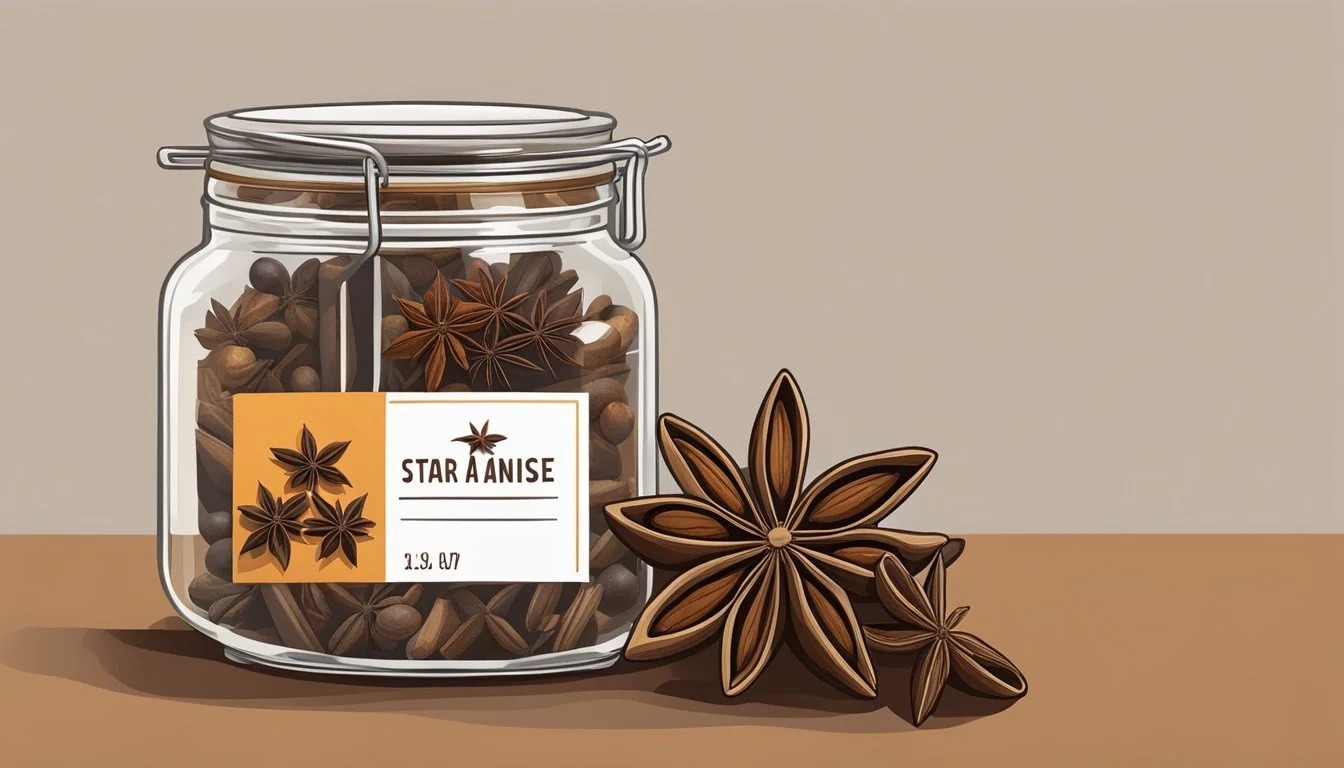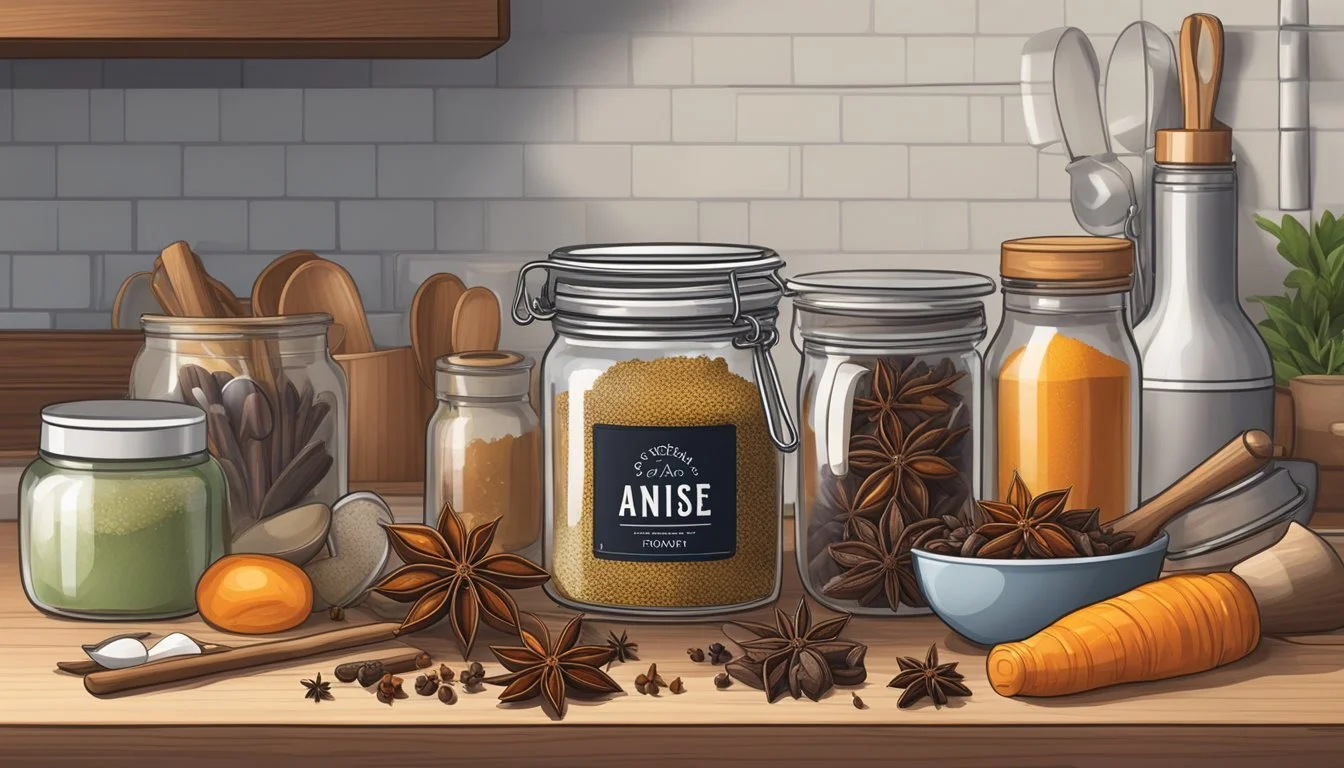How Long Does Star Anise Last?
Shelf Life and Storage Tips
Star anise is a spice known for its distinct flavor and fragrant aroma, commonly used in various cuisines around the world. The longevity of star anise is a question that arises for those who do not use it regularly but wish to maintain its potency over time. Stored properly in a cool, dry place in an airtight container, star anise retains its quality.
The longevity and preservation of star anise are influenced by its form, whether whole or ground. Whole star anise tends to last longer than the ground variety due to its reduced surface area, which slows down the oxidation process that leads to flavor loss. Generally, whole star anise can remain fresh and effective for about a year if stored correctly.
The efficiency of star anise in cooking is maximized when it is fresh, as aging can diminish its pungent taste and aroma. Therefore, cooks often look for signs of freshness, such as a strong smell and unbroken stars. If vacuum sealing is an option, it may extend the shelf life by preventing exposure to air and moisture.
Understanding Star Anise
Star anise, with its rich aroma and distinct flavor, is a spice hailing from Asia, integral to culinary and medicinal practices there.
Botanical Profile
Star anise is the fruit of an Illicium verum tree, a type of evergreen native to Southeast Asia, particularly Vietnam. It's identified by its star-shaped pericarp with each arm housing a single seed. This spice is not only valued for its culinary applications but also for the essential oil derived from the seeds. (how long do seeds last?)
Type: Evergreen tree
Scientific Name: Illicium verum
Origin: Southeast Asia (notably Vietnam)
Fruit: Star-shaped capsule
Culinary History
Star anise has been a staple in Asian cuisine for centuries. Known as Chinese star anise, it provides a strong, sweet, and licorice-like aroma, an essential component in Asian cooking. This spice plays a crucial role in the famous Chinese five-spice powder (how long does chinese five-spice powder last?) and is commonly used in pho, a Vietnamese noodle soup.
Common Name: Chinese star anise
Uses: Component in five-spice powder, pho seasoning
Flavor Profile: Sweet, licorice-like aroma
Culinary Uses
Star anise is a versatile spice that infuses dishes with a licorice-like flavor. It is common in Chinese and Vietnamese cuisines and plays a crucial role in both sweet and savory recipes.
Flavor Profile
Star anise has a sweet and aromatic flavor, reminiscent of licorice, with subtle notes of cinnamon and cloves. It is often a key ingredient in Chinese five-spice powder, which pairs it with fennel (how long does fennel last?) seeds, cinnamon, cloves, and Szechuan peppercorns. The spice is also comparable to fennel seed and anise due to the shared compound anethole, which is responsible for the licorice taste.
Common Dishes
In Chinese cuisine, star anise is frequently used in braised meat dishes, imparting its unique flavor to pork belly and chicken. It is also essential in crafting rich stews and marinades that require a depth of flavor.
In Vietnamese dishes, the spice is renowned for its contribution to Pho, a national dish featuring a broth seasoned with star anise and other spices. Star anise also complements fattier meats well, balancing the richness with its pronounced taste.
Culinary Techniques
When cooking with star anise, one must consider the intensity of the spice. It is typically used whole and removed before serving, or ground into powder form. For teas and infusions, the whole pod is simmered to extract its full flavor. A common technique is to add star anise early in the cooking process for soups (What wine goes well with soups?) and stews, allowing its flavor to meld with the other ingredients.
Star Anise Storage
Proper storage of star anise extends its shelf life and preserves its potent flavor. Attending to factors such as airtight containment and environmental conditions is critical for both whole and ground varieties.
Longevity Factors
Star anise longevity is influenced by several key variables. To maintain its freshness and aromatic qualities, star anise should be protected from moisture, light, and heat. Whole star anise typically has a longer shelf life than ground star anise due to less surface area being exposed to the elements, which can lead to quicker loss of flavor and aroma.
Moisture: Always store star anise in a dry place to prevent mold and spoilage.
Light: Exposure to sunlight can degrade the quality of star anise over time.
Heat: High temperatures can cause star anise to lose its flavor more rapidly.
Storage Methods
Effective storage methods are vital to preserve the quality of both whole and ground star anise.
Airtight Container: Use an airtight container to shield star anise from moisture and other environmental factors.
Environment: The ideal storage temperature is between 50°F and 70°F (10°C and 21°C).
State Container Location Whole Star Anise Airtight container Cool, dry place Ground Star Anise Sealed, airtight container Away from heat and light
Employing these storage methods effectively can assist in keeping star anise as fresh and dried as possible for culinary uses.
Star Anise Alternatives
When star anise is unavailable, several alternatives offer a similar licorice-like flavor to dishes. Selecting the right substitute depends on the desired flavor profile and intensity.
Substitute Options
Anise Seed: It provides a similar licorice taste and can be used in a 1:1 ratio for whole star anise.
Chinese Five-Spice Powder: Containing star anise, it maintains the dish's intended flavor profile.
Fennel Seeds: Shares a licorice flavor and can be used in a 1:1 ratio for whole star anise.
Allspice: Offers a warm, sweet note but lacks the licorice undertone.
Table: Measurement Ratios for Substitutes
Substitute Ratio to Star Anise Anise Seed 1:1 Chinese Five-Spice Powder To taste, as it's a blend Fennel Seeds 1:1 Allspice Start with half the amount and adjust to taste
Flavor Comparisons
Anise Seed: They have a milder intensity compared to star anise and can be used as a direct replacement, both whole and ground.
Chinese Five-Spice Powder: Though it contains star anise, other spices in the blend, like cinnamon and cloves, alter the flavor.
Fennel Seeds: They are more aromatic and less pungent, suitable for savory and sweet dishes.
Allspice: While it contributes a sweet and warm note, it does not mimic the licorice essence of star anise and might change the dish's flavor profile significantly.
Health Benefits and Risks
Star anise, renowned for its culinary and medicinal applications, possesses both beneficial properties and certain risks worth considering.
Medicinal Properties
Star anise harbors shikimic acid, an ingredient crucial in the production of antiviral medications, including Tamiflu, which is used to treat influenza. The spice's significant antioxidant and anti-inflammatory components contribute to health by neutralizing harmful free radicals and reducing inflammation. Anethole, the primary compound of star anise, is noted for its antibacterial properties and potential in treating bacterial infections such as those caused by E. coli.
Antiviral: Effective against various viral infections including influenza.
Antioxidant: Protects cells from oxidative stress.
Anti-inflammatory: Helps alleviate swelling and pain.
Shikimic Acid: Vital for antiviral drug synthesis.
Anethole: Exhibits antibacterial activity.
Potential Hazards
Despite its health benefits, star anise can be toxic if consumed inappropriately. Specifically, Japanese star anise is known to contain toxic compounds that may cause seizures, and it should not be ingested, as it is poisonous and not meant for medicinal use. It is crucial to differentiate between the Chinese variety, which is safe for consumption, and the Japanese variety.
Toxicity: Japanese star anise is poisonous and not for consumption.
Seizures: Ingestion of toxic compounds in Japanese star anise can lead to adverse neurological effects.
Consumers should ensure that they are purchasing the edible Chinese star anise and using it in appropriate quantities to mitigate these risks.
Buying and Selecting Quality Star Anise
When purchasing star anise, consumers should focus on indicators of freshness and understand the varietal differences to ensure they select a high-quality spice.
Identifying Freshness
Freshness is paramount when buying whole star anise, as it ensures the maximum flavor and shelf life. Buyers should look for star anise with a strong licorice aroma, which indicates high essential oil content and freshness. The fruit should be intact, with a robust shape and a rust-brown color that denotes maturity. Ground star anise tends to lose its potency faster, so purchasing whole pods is preferable. Buyers should avoid star anise with broken pieces or a very dull color, as these are signs of age or improper handling.
Varietal Differences
Star anise comes primarily in two species: the Chinese Illicium verum and the Japanese Illicium anisatum. The former is considered superior for culinary uses with its potent flavor profile suitable for both savory and sweet dishes. When buying star anise, one should ensure they are purchasing the Illicium verum variety, as the Japanese star anise is inedible and toxic if ingested. Quality star anise should have eight-pointed star pods with each arm housing a single, shiny seed which signifies the verum variety known for its culinary use.
Incorporating Star Anise in Various Cuisines
Star anise, with its distinct licorice flavor and aromatic fragrance, is a versatile spice that plays a central role in many Asian dishes and has intriguing applications in European cuisines. Known for its compatibility with meat dishes and the necessity of moderation in its use, star anise enhances flavor profiles profoundly.
Asian-Inspired Recipes
In Chinese cooking, star anise is a quintessential ingredient. It imparts a sweet and spicy undertone to savory dishes such as braised meats (What wine goes well with braised meats?) and is essential in the creation of five-spice powder. Vietnamese noodle soup often relies on star anise for its signature broth; a single pod can transform the soup's foundation with its complex flavor.
Key Ingredients:
Braised meats: Star anise, soy sauce, sugar
Pho broth: Star anise, cinnamon, cloves, cardamom
European and Fusion Dishes
Across Europe, star anise finds its way into a variety of meat dishes, where it's used with a light touch due to its potency. Though less prevalent than in Asian cuisine, its presence in European and Fusion cooking adds a nuanced taste to slow-cooked recipes and is occasionally used for poaching fruits, demonstrating its flexibility.
Usage Tips:
Moderation: A single pod can often suffice for a dish serving several people.
Pairing with meats: Star anise pairs well with fattier cuts, enhancing their flavor without overpowering the dish.
Star Anise in Beverages and Confectionery
Star anise is esteemed for its sweet, liquorice taste that enhances a variety of beverages and sweets, providing a unique aromatic profile and an element of sweetness to drinks and confectionery items.
Drinks
Tea: Star anise is a staple in many tea blends, particularly chai, where it imparts a warm, sweet note. One to two pods are usually sufficient for a pot of tea to achieve the desired flavor depth.
Mulled Wine & Cider: This spice is a key ingredient in mulled beverages where it adds a layer of spicy sweetness. Typically, one whole star anise is adequate for a standard batch.
Cocktails & Liqueurs: It’s used cautiously in cocktails and liqueurs for a bold, distinct undertone, often paired with spirits such as sambuca, absinthe, and pastis.
Table: Star Anise Utilization in Beverages
Beverage Type Suggested Usage Note Tea 1-2 pods per pot Adds warmth and sweetness to blends Mulled Drinks 1 pod in mulled wine or cider Infused to contribute a complex flavor Liqueurs Varies depending on recipe Used for its sweet, anise-like flavor Cocktails As per recipe – generally sparingly To introduce a licorice note and aroma
Desserts and Sweets
Cakes & Cookies: Bakers appreciate star anise for its ability to infuse cakes and cookies with a delicate licorice essence, usually ground into powder form before being added to the batter. It pairs well with fruits and other spices.
Sweet Desserts: Its licorice taste complements the natural sweetness in desserts, balancing and elevating flavors. Star anise is often incorporated into creamy desserts, (What wine goes well with creamy desserts?) custards, and fruit compotes to add complexity.
Table: Star Anise Applications in Sweets
Sweet Type Application Note Cakes & Cookies Ground star anise added to batter Enhances flavor without overpowering Desserts Whole or ground pods infuse custards Provides depth to sweetness
In both beverages and confectionery, star anise is used to add distinctive flavor. Its versatility can be maximized with careful measurement to ensure a balance that complements, rather than overwhelms, the primary tastes of the recipes.
Kitchen Tips and Tricks
This section delves into the nuanced use of star anise in culinary applications and optimal practices to harness its potent flavor.
Enhancing Flavors
Star anise imparts a warming, savory quality to dishes. Its complex sweetness and aniseed flavor are well-suited for infusing broths, stews, and sauces. To retain its bold essence, one can add star anise to meats or braised dishes (What wine goes well with braised dishes?), which absorb its distinctive taste. For a complementary touch, chefs may incorporate star anise into preparations with fruits such as poached pears, where it lends a rich, caramelized undertone.
Savory Dishes: Infuse star anise early in the cooking process to meld with meats and vegetables.
Sweet Pairings: Complement fruits by adding star anise to syrups or dessert sauces.
Proper Usage in Cooking
Utilizing star anise effectively in cooking hinges on balance and substitutional wisdom. It should be used sparingly to prevent overwhelming other flavors. When ground, star anise is a key component of Chinese five-spice powder, where its robust profile harmonizes with other brown spices. If one requires a star anise substitute, a blend of anise seeds with a pinch of allspice can mimic its character.
Star Anise Quantities: Begin with a single pod and adjust to taste for a balanced flavor.
Substitution: Combine anise seeds (1/2 teaspoon) with allspice (a pinch) as a substitute in a pinch.
It's critical to note that star anise contains essential oil, anethole, which is responsible for its distinct flavor, but when used excessively can dominate a dish. Whether incorporated through leaves or pods, moderated incorporation ensures an aromatic yet not overpowering presence in culinary creations.
Understanding Anise and Fennel
In examining anise and fennel, it is clear that both herbs are renowned for their licorice-like flavor and are often used to add a layer of sweetness to a variety of dishes. However, despite their similarities, they maintain distinct identities and uses in the culinary world.
Comparative Overview
Anise, also known as aniseed, is a small, brown seed from the Pimpinella anisum plant in the parsley family. It has a strong, sweet taste and is used for its aromatic seeds that bear a close resemblance, flavor-wise, to licorice. Unlike fennel, anise seeds are not typically used as a vegetable.
On the other hand, fennel is a versatile herb with a slightly milder licorice flavor compared to anise. It consists of a white or pale green bulb from which stalks grow into feathery leaves. Both the bulb, seeds, and fronds of the fennel plant are edible. The seeds, in particular, share a family with anise – both part of the parsley family – but fennel seeds are often seen as less intense, imparting a softer sweetness akin to that of a pear when used in cooking.
Anise Fennel Plant Type Seed Herb Family Parsley Family Parsley Family Flavor Strong Licorice Mild Licorice Sweetness More pronounced Subtly akin to pear Used as Spice Vegetable/Spice
Usage in Global Cooking
Anise seeds are often used to flavor dishes, desserts, and beverages worldwide. Their potent licorice flavor is popular in spice rubs and baked goods such as biscuits and cakes. In European cuisine, anise is a characteristic ingredient in a variety of breads, while Mediterranean and Middle Eastern cuisines incorporate it into meat and vegetable dishes for added sweetness and a burst of aromatic notes.
Fennel seed, owing to its mild sweetness and slight anise-like taste, is also a spice that commands global reverence. It is found in Italian sausages, Indian curries, and traditional Chinese five-spice powder. The versatility of fennel is further demonstrated as it brightens savory dishes like stews and soups, and its bulb can be used raw in salads for a crunchy, faintly sweet addition.











